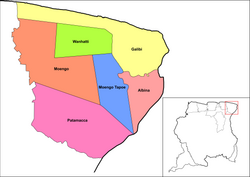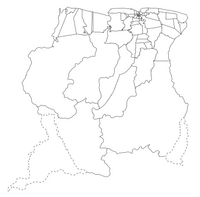|
Wanhatti
Wanhatti is a village and resort in Suriname, located in the Marowijne district on the Cottica River.[2] The resort is inhabited by the Ndyuka Maroons, and has a population of 468 people as of 2012.[1] The village is primarily inhabited by Ndyuka of the Ansu clan or lo.[3] NameWanhatti means "one heart" in both Sranan Tongo and Ndyuka and refers to the fact that the village is a merger of the villages of Agiti Ondoo and Walimbumofu.[4][3] HistoryAgiti Ondoo was the site of a Gaan Gadu shrine.[5] In 1972, a road was built to connect Wanhatti to the East-West Link. The road partially uses the path of the old defence line,[6] build between 1770 and 1778 to protect the plantations of the Colony of Suriname against attacks by the Maroons.[7] The road improved conditions in the village, and it now has a school, and a connection to the telephone network.[6] The Surinamese Interior War fought during the 1980s left its toll on the resort, and caused a large part of the population to flee.[8] In September 2010, a health care clinic was opened in the village.[9] In 2011, the road was extended to reach the village Lantiwee,[6] and it is hoped that this will lead to a return of farmers in the area.[10] On 3 June 2011, a library was opened in the village.[11] Besides Wanhatti itself, the resort contains among others the villages of Lantiwee, Pikin Santi, Pinatjaimi, and Tamarin. Aluku MaroonsFort Buku, a famous Aluku Maroon fort of the Boni War that fell in 1772, is located within the Wanhatti resort, however the fort itself still has to be discovered as of 2020.[12] The Ndyuka signed a peace treaty in 1760.[13] Boni also desired a peace treaty, but the Society of Suriname, despite contrary advice from the Dutch government, wanted to persecute and destroy the Aluku.[14] In 1777, the French send a diplomatic mission to Suriname, to discuss the refugee crisis.[15] Notes
ReferencesWikimedia Commons has media related to Wanhatti.
|
||||||||||||||||||||||||||||||
Portal di Ensiklopedia Dunia



